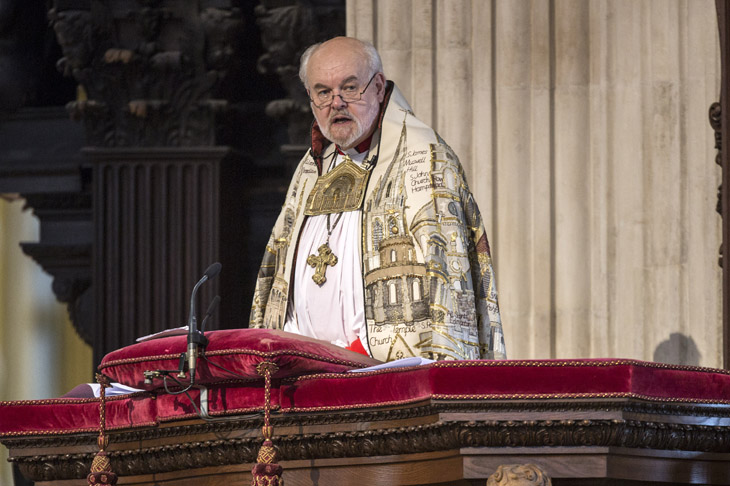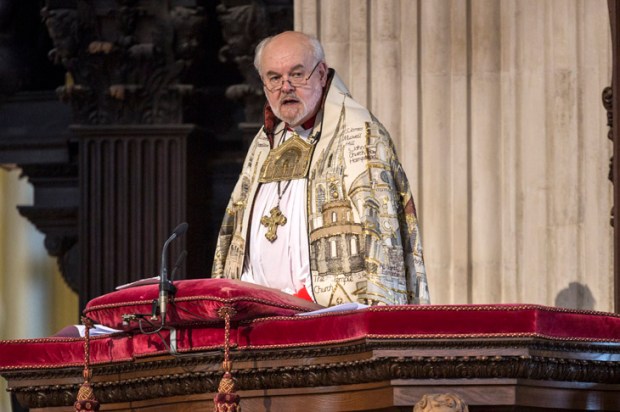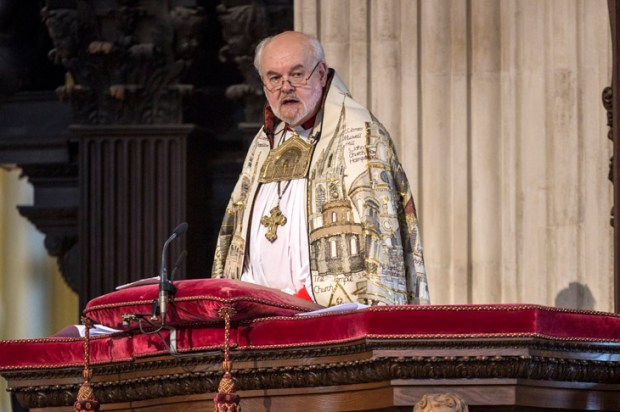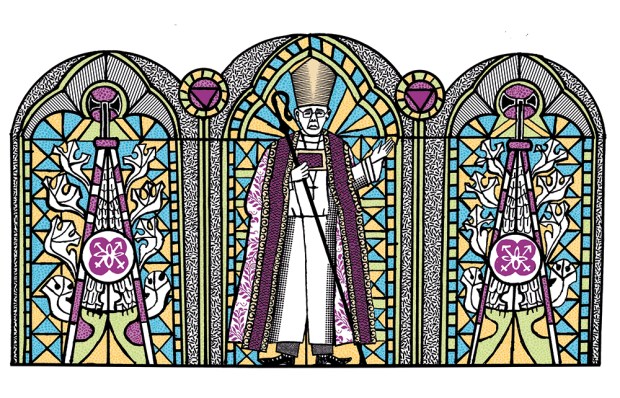In typical theatrical style, the outgoing Bishop of London, Richard Chartres, he of the sonorous voice and imposing beard, ‘never knowingly underdressed’, ‘the last of the great prince bishops’, attended his final service as bishop at last Thursday’s liturgy at St Paul’s Cathedral for Candlemas — the day on which Simeon spoke the words, ‘Lord, now lettest thou thy servant depart in peace.’
Some say Chartres has become rather too fond of dining with the royal family recently and has neglected the duller duty of getting to know his lesser clergy; but the general consensus is that, in his 21 years in the post, through sheer charm and force of character, he has brilliantly managed to keep the almost impossibly polarised diocese of London together. Under his tenure, London has changed from being ‘the problem diocese’ (in terms of numbers) to the great success story.
And so the long-drawn-out process to find his replacement trundles into gear. It will take till November. You hear it bandied about that ‘Theresa May would like the next Bishop of London to be a woman.’ Well, she might, but the fact is that since Gordon Brown changed the rules, the Prime Minister has no say in the matter. Brown (son of the manse) felt so uncomfortable about exercising patronage in the Church of England that he put a stop to it, even though Jack Straw advised him not to change a system that worked. In doing so, he abolished the kind of prime-ministerial whimsicality that had allowed Margaret Thatcher to choose Carey over Habgood. But the change chopped in half the number of ‘gatekeepers’ gathering the names of inspirational high-fliers.
The hub of bishop-choosing is now start-lingly undemocratic — ‘hardly better’, as one clergyman put it to me, ‘than the bad old days of a few men sitting round the club table at the Athenaeum’. It all comes down to Who Keeps The Pool. ‘The Pool’ is the highly secret list of those deemed to be ready to be a bishop in high office. Its nickname is the ‘Ready Now List’, or the ‘Oven Ready List’. Before Gordon Brown, both the Prime Minister’s appointments secretary and the Archbishops of Canterbury and York’s appointments secretary kept lists. Now, the sole keeper of the list is a woman called Caroline Boddington, the archbishops’ appointments secretary, a layperson who happens to be the wife of the Bishop of Derby. She has become more and more influential during her 11 years in the role. Because she works at Lambeth Palace and hangs out with the Archbishop of Canterbury all the time, the sense is that ‘if your face doesn’t fit’ with those two at Lambeth, you’ve got no hope of getting on to the list.
Alongside that unhealthily one-sided gatekeeper situation, the next part of the system has become so politically correctly democratic and committee-led that there seems no chance of choosing anyone exciting. The diocese’s vacancy-in-see committee draws up a profile of the kind of person they’d like the new bishop to be, taking soundings from all over the diocese. (The London profile is likely to be ‘Nice friendly married person who knows London, not too raving Evangelical, not too raving High, who has worked in London before and has grown-up children and a few grandchildren and a dog.’) The diocese elects six of its members to join up with the six members of the Crown Nominations Commission (three clergy, three lay, evened out between High and Low), who, with the two archbishops (so, 14 people in all), will meet twice to interview four candidates from The Pool, all of whom tick the boxes on the diocesan profile. The four candidates have to write personal statements, trying to tread the fine line between proving their suitability for the job and not showing off, before being summoned to Lambeth for a day of interviews. The competitive spirit of that day doesn’t tally with most candidates’ training in self-effacement.
In recent years it has tended to be the case that if those six people from the diocese are united in wanting a particular candidate to win, that candidate does win. It used to be four from the diocese and six from the national church, but now it’s six-six. The result is that the needs of the national church no longer take precedence over the needs of the diocese — which tends to count against the maverick brilliant theologian types. Dioceses say, ‘We don’t want a dry and dusty theologian, do we?’ This, say some, is a bad state of affairs: we need our theologian bishops, even if they are dry and dusty, which they aren’t necessarily.
A vote is taken, and the majority must be at least two thirds, although I’m not sure what two thirds of 14 is. It used to be that two names were put forward to the Prime Minister for him or her to choose from. Now one name is put forward: the second is only there in case the first one doesn’t accept the post. The Chosen One receives a letter from the Prime Minister, who has had no role in the process.
So, who might be on the Oven Ready List and be about to be plucked out as one of those four candidates for Bishop of London? Generally, for the grand post of Bishop of London, which includes being a privy councillor as well as a seat in the House of Lords, you need to have been a diocesan bishop already. Since the vote for women to be bishops was passed in 2014, only two women have been made diocesan bishops. One is Rachel Treweek (Gloucester) — lovely, but won’t set the world on fire (typical line from one of her sweet sermons: ‘My story and who I am is no greater or any less than your story’); and Christine Hardman (Newcastle) — also lovely but does not seem sufficiently large of stature. Those two haven’t been in post for long enough to be Bishop of London yet, most believe. So it probably won’t be a woman. The once-tipped June Osborne and Vivienne Faull seem to have been shunted into sidings as cathedral deans and may well go no further.
The next burning question is, ‘Might it be Nicky Gumbel?’, the vicar of Holy Trinity Brompton. ‘I’d be very surprised if Gumbel’s name was not on Caroline Boddington’s list,’ one bishop said to me, slightly despairingly. But the general feeling ranges from ‘Surely not’ to ‘Please God, no’. Yes, it’s true that 27 million people have taken the Alpha Course, which HTB started. Yes, 1.7 million people across the world have downloaded Gumbel’s Bible in One Year (with his commentary) and read it every morning over their muesli and soya milk. Yes, Gumbel is an Old Etonian who could probably hold his own among the great and good of the City. But he has hardly ever been out of his HTB bubble. It’s a gigantic bubble, but a bubble nonetheless. He was curate and vicar at the same church. He hasn’t had nearly enough breadth of ecclesiological experience to understand and hold the extreme ends of the Church together.
Which brings us to the heart of the (probable) list: the Stephens, Grahams, Toms and Adrians who are doing well as bishops in their dioceses but are now deemed ready for promotion. The good news is that there are some extremely impressive ones around at the moment, and there’s a strong hope we’ll get someone good. The bad news is that none, but none, of them has a voice as gloriously sonorous as Richard Chartres.
There’s Adrian Newman, Bishop of Stepney, who cares about cities and emphasises that the Bible begins in a garden (Eden) but ends in a city (the heavenly Jerusalem). An official biographical note describes him as ‘married to Gill with three grown-up children and a mad black labrador’. He ticks all those boxes. (No chance of a practising gay Bishop of London yet. The most you can be is gay and officially celibate, but even that will hamper you.) If Newman got the job, though, it would be a bit of a comedown in terms of beard: Newman has a Gary Lineker-type ‘Van Dyke’, with a thin vertical line of facial hair going down from bottom of mouth to goatee.
Then there’s the ‘boy bishop’, as he’s known, because he looked about 12 when he was installed as Bishop of Truro. Tim Thornton is his name: he knows London, having been chaplain to a previous bishop, but he might not have quite enough charisma to carry the job off. There’s delightful Stephen Conway of Ely (Anglo-Catholic), and Bible-bashing Graham Tomlin of Ken-sington (Evangelical).
But my money (and other people’s, too) would be on Stephen Cottrell, the Bishop of Chelmsford. He was state-educated in Leigh-on-Sea, so can be ‘a bit cor-blimey’, as some have said to me. It’s true that his recent talk in the cathedral to his clergy included the phrases ‘Who gives a toss?’, ‘Flush down the toilet’ and ‘What the bloody hell?’ But he grows on you. He’s a scintillating public communicator, straddles both the Evangelical and the Anglo-Catholic traditions, is self-deprecating, funny, articulate and imaginative. If he’s chosen, we’ll just have to blot out the Chartres voice from our memory: no point in comparing them.
Got something to add? Join the discussion and comment below.
Get 10 issues for just $10
Subscribe to The Spectator Australia today for the next 10 magazine issues, plus full online access, for just $10.














Comments
Don't miss out
Join the conversation with other Spectator Australia readers. Subscribe to leave a comment.
SUBSCRIBEAlready a subscriber? Log in